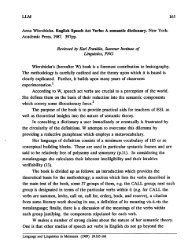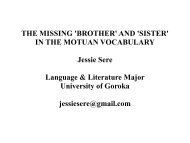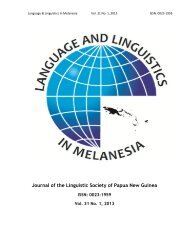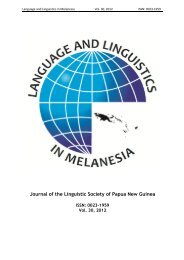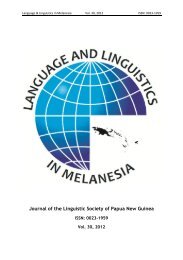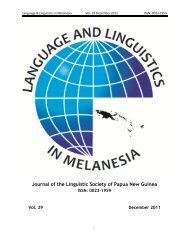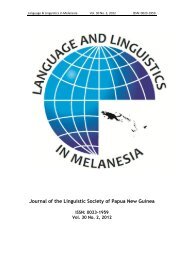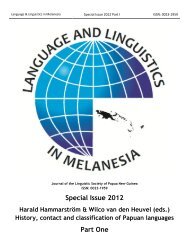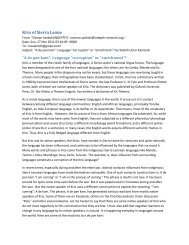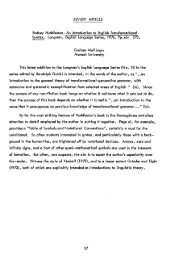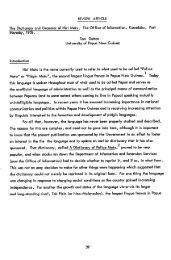Journal of the Linguistic Society of Papua New Guinea
Journal of the Linguistic Society of Papua New Guinea
Journal of the Linguistic Society of Papua New Guinea
Create successful ePaper yourself
Turn your PDF publications into a flip-book with our unique Google optimized e-Paper software.
Language & <strong>Linguistic</strong>s in Melanesia Vol. 30 No. 2, 2012 ISSN: 0023-1959<br />
sentence constituents, increasing <strong>the</strong>ir pixel resolution. ‘Generalizing’ syntactic analysis aims to<br />
elucidate both aspects <strong>of</strong> <strong>the</strong> process; <strong>the</strong>refore, G-nalysis uses a two-step procedure:<br />
1. The first step is to identify <strong>the</strong> major ‘parts’ <strong>of</strong> all <strong>the</strong> nexal patterns present in <strong>the</strong> overall<br />
syn<strong>the</strong>sis (sentence mosaic).<br />
2. The second step, once all <strong>the</strong> S/V/C patterns have been identified, is to figure out how all <strong>the</strong><br />
clauses (S/V/Cs), phrases, and words relate to each o<strong>the</strong>r – what do <strong>the</strong>y actually do in <strong>the</strong><br />
sentence This is done by asking <strong>the</strong> relevant logical questions, which will identify <strong>the</strong> function/<br />
‘part <strong>of</strong> speech’ <strong>of</strong> <strong>the</strong> word, phrase, or clause in <strong>the</strong> sentence.<br />
Relationships between nexal patterns are indicated by simple diagrams, where quadrangles represent<br />
independent SVCs, and triangles – dependent SVCs:<br />
C 1(PA) +(IO), not (IO)<br />
S 1 V 1 C 1(PA) C 2 (IO) S 2 V 2 C 3(IO) S 3 V 3<br />
// I / am / only responsible for what / I / say /, not /for what / you / understand //.<br />
How What What<br />
S 1 V 1 C 1<br />
Two Noun Clauses = Indirect Objects embedded in <strong>the</strong> Complement 1 slot<br />
not<br />
Re-cap <strong>of</strong> G-nalysis basics:<br />
It is <strong>the</strong> common function (purpose, <strong>the</strong> fusion <strong>of</strong> semantic and grammatical meaning) <strong>of</strong> words working<br />
toge<strong>the</strong>r that binds <strong>the</strong>m into a unit <strong>of</strong> compound meaning, ei<strong>the</strong>r naming something in <strong>the</strong> nexus<br />
(noun function) or adding detail to a sentence constituent (adjective or adverb function).<br />
Phrases are different from dependent clauses only structurally: while clauses have <strong>the</strong>ir own nexal<br />
patterns (S/V/Cs), phrases do not; both phrases and dependent clauses are defined by <strong>the</strong>ir common<br />
function: words in <strong>the</strong>m work toge<strong>the</strong>r as one part <strong>of</strong> speech (noun, adjective, or adverb).<br />
Thus, <strong>the</strong> universal Rational Mechanism <strong>of</strong> Language (generalization) works through <strong>the</strong> syn<strong>the</strong>sis <strong>of</strong><br />
word-meanings into <strong>the</strong> nexus <strong>of</strong> <strong>the</strong> sentence and analysis (description, modification, specification) <strong>of</strong><br />
<strong>the</strong> nexus constituents:<br />
<br />
<br />
Syn<strong>the</strong>sis connects <strong>the</strong> ‘bones’ <strong>of</strong> <strong>the</strong> ‘skeleton’ into <strong>the</strong> ‘Subject, Verb, Complement’ pattern <strong>of</strong><br />
<strong>the</strong> proposition; <strong>the</strong>ir nexus (in whichever order <strong>the</strong>y come)represents <strong>the</strong> linear (syntagmatic)<br />
relationship between <strong>the</strong>m, and<br />
Analysis zooms in on <strong>the</strong> major parts <strong>of</strong> <strong>the</strong> sentence mosaic & describes <strong>the</strong>m by resemblance,<br />
cause/effect & contiguity in space/time – it puts ‘flesh’ on <strong>the</strong> bones <strong>of</strong> <strong>the</strong> sentence.<br />
38



